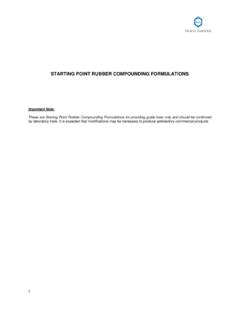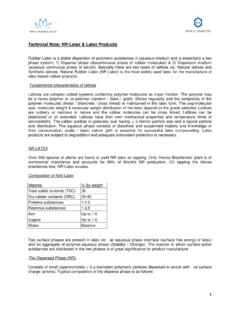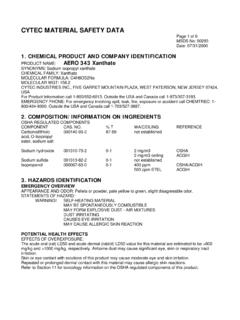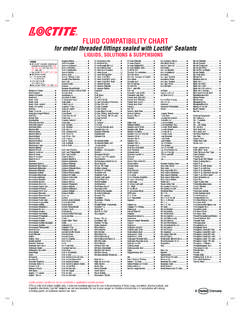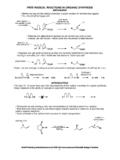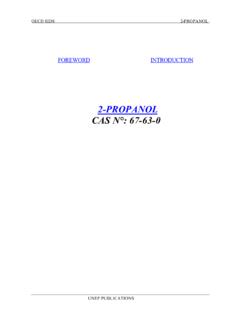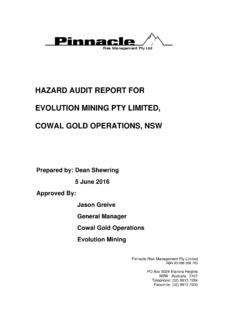Transcription of Vulcanization & Accelerators - Nocil Ltd
1 1 Vulcanization & Accelerators Vulcanization is a cross linking process in which individual molecules of rubber (polymer) are converted into a three dimensional network of interconnected (polymer) chains through chemical cross links(of sulfur). The Vulcanization process was discovered in 1839 and the individuals responsible for this discovery were Charles Goodyear in USA and Thomas Hancock in England. Both discovered the use of Sulfur and White Lead as a Vulcanization system for Natural Rubber. This discovery was a major technological breakthrough for the advancement of the world economy. Vulcanization of rubbers by sulfur alone is an extremely slow and inefficient process. The chemical reaction between sulfur and the Rubber Hydrocarbon occurs mainly at the C = C (double bonds) and each crosslink requires 40 to 55 sulphur atoms (in the absence of accelerator ).
2 The process takes around 6 hours at 140 C for completion, which is uneconomical by any production standards. The vulcanizates thus produced are extremely prone to oxidative degradation and do not possess adequate mechanical properties for practical rubber applications. These limitations were overcome through inventions of Accelerators which subsequently became a part of rubber compounding formulations as well as subjects of further R&D. Following is the summary of events which led to the progress of Accelerated Sulfur Vulcanization '. Event Year Progress - Discovery of Sulfur Vulcanization : Charles Goodyear. 1839 Vulcanizing Agent - Use of ammonia & aliphatic ammonium derivatives: Rowley. 1881 Acceleration need - Use of aniline as accelerator in USA & Germany: Oenslager. 1906 Accelerated Cure - Use of Piperidine accelerator - Germany. 1911 New Molecules - Use of aldehyde-amine & HMT as Accelerators in USA & UK 1914-15 Amine Accelerators - Use of Zn-Alkyl Xanthates Accelerators in Russia.
3 1919-20 New Molecules - Use of Thiurams & Dithiocarbamates -Germany. Speed Control - Effect of ZnO on cure rate, discovery of DPG, MBT, MBTS. 1919-22 Delayed Action - R & D efforts for more effective delayed action Accelerators . 1930 Delayed Action - Sulfenamide accelerator developed- USA. 1937 Delayed Action - Several other Sulfenamide Accelerators developed 1945 .. Delayed Action - Pre Vulcanization Inhibitor CTP- USA 1970 PVI - Post Vulcanization Stabilizers PVS 2 Sulfur remains the most successful and economical cross linking agent even today! Sulfur as vulcanizing agent has a limitation that, the elastomers must contain chemical unsaturation (C=C double bonds) for sulfur cross linking. The structure of speciality elastomers EPDM and Butyl had to be chemically modified to make sulfur Vulcanization possible for their commercial success.
4 Other chemicals used for cross linking of polymers are Sulfur Monochloride, Tellurium, Selenium, Thiuram Accelerators , Polysulphide polymers, p-Quinonedioximes, Metallic Oxides, Organic Peroxides, Di-isocyanates, etc. (mostly for specialized applications). In the case of fully saturated elastomers organic peroxides are often used for cross linking. Accelerators : An accelerator is defined as the chemical added into a rubber compound to increase the speed of Vulcanization and to permit Vulcanization to proceed at lower temperature and with greater efficiency. accelerator also Decreases the Quantity of Sulphur necessary for Vulcanization and thus improving 'aged' properties of the rubber vulcanizates. Classification of Accelerators : Accelerators Chemical Group Vulcanization Speed BA, HMT Aldehyde Amine Slow DPG, DOTG Guanidine Slow MBT, MBTS, ZMBT Thiazole Semi Ultra fast ZBDP Thiophosphate Ultra fast CBS, TBBS, MBS, DCBS Sulfenamides Fast-Delayed action ETU, DPTU, DBTU Thiourea Ultra fast TMTM, TMTD, DPTT, TBzTD Thiuram Ultra fast ZDMC, ZDEC, ZDBC, ZBEC Dithiocarbamate Ultra fast ZIX Xanthates Ultra fast Accelerators are also classified as Primary and / or Secondary Accelerators based on the role they play in a given compound.
5 Generally, Thiazoles and Sulfenamide Accelerators play a role of being Primary Accelerators due to their characteristics such as good processing safety, a broad Vulcanization plateau and optimum cross link density as well as desired reversion delay that they offer. The Primary Accelerators are used at to phr dosages in most rubber compounds. The basic Accelerators such as Guanidines, Thiurams, and Dithiocarbamates etc are used as Secondary Accelerators to activate the primary Accelerators . The use of secondary Accelerators increases the speed of Vulcanization substantially but at the expense of scorch safety. The dosages of the secondary Accelerators are generally between 10-40% of the primary accelerator . 3 Accelerators some times are also be classified according to the chemical groups to which they belong.
6 Over 150 different chemicals belonging to different classes of composition are known to function as Accelerators for rubber Vulcanization of which around 50 Accelerators are most commonly used by the Rubber Industry. 4 Commonly used Accelerators : accelerator Chemical Structure Remarks Hexamethylene Tetramine (HMT) Group: Amines. Speed: Scorchy & Slow cure rate. Use: As a secondary accelerator Heptaldehyde-Aniline condensation Product (BA) Group: Aldehyde-Amines. Speed: Scorchy & Slow cure rate. Use: As a Primary accelerator . Diphenyl Guanidine (DPG) Group: Guanidines. Speed: Scorchy & Slow cure rate. Use: As a Primary & Secondary accelerator N, N -Diorthotolyl Guanidine (DOTG) Group: Guanidines. Speed: Scorchy & Slow cure rate. Use: As a Primary & Secondary accelerator 2- Mercaptobenzothiazole (MBT) Group: Thiazoles.
7 Speed: Scorchy Ultra fast. Use: As a Primary accelerator 2-2 -Dithiobis(benzothiazole) (MBTS) Group: Thiazoles. Speed: Less scorchy than MBT. Ultra fast. Use: As a Primary accelerator Zinc-2-mercaptobenzothiazole (ZMBT) Group: Thiazoles. Speed: Scorchy. Ultra fast. Use: As a Primary accelerator Zinc-O,O-di-N-phosphorodithioate (ZBDP) Group: Thiophosphate. Speed: Scorchy. Ultra fast. Use: As a Primary accelerator N-Cyclohexyl-2-benzothiazole sulfenamide (CBS) Group: Sulfenamides Speed: Delayed Action. Ultra fast. Use: As a Primary accelerator N-tert-butyl-2-benzothiazole sulfenamide (TBBS) Group: Sulfenamides Speed: Delayed Action. Ultra fast. Use: As a Primary accelerator 2-(4-Morpholinothio)-benzothiazole (MBS) Group: Sulfenamides Speed: Delayed Action. Ultra fast. Use: As a Primary accelerator N,N -dicyclohexyl-2-benzothiazole sulfenamide (DCBS) Group: Sulfenamides Speed: Delayed Action. Ultra fast. Use: As a Primary accelerator 5 accelerator Chemical Structure Remarks Ethylene Thiourea (ETU) Group: Thioureas Speed: Ultra fast.
8 Use: As a Primary / Secondary accelerator Di-pentamethylene Thiourea (DPTU) Group: Thioureas Speed: Ultra fast. Use: As a Primary / Secondary accelerator Dibutyl Thiourea (DBTU) Group: Thioureas Speed: Ultra fast. Use: As a Primary / Secondary accelerator Tetramethylthiuram Monosulfide (TMTM) Group: Thiurams Speed: Ultra fast. Use: As a Primary / Secondary accelerator . Not a sulfur donor Tetramethylthiuram Disulfide (TMTD) Group: Thiurams Speed: Ultra fast. Use: As a Primary / Secondary accelerator , Sulfur donor Dipentamethylenethiuram tetrasulfide (DPTT) Group: Thiurams Speed: Ultra fast. Non-nitrosamine Use: As a Primary / Secondary accelerator , Sulfur donor. Tetrabenzylthiuram Disulfide (TBzTD) Group: Thiurams Speed: Ultra fast. Use: As a Primary/ Secondary accelerator , Non-nitrosamine, Sulfur donor. Zinc dimethyldithiocarbamate (ZDMC) Group: Dithiocarbamates Speed: Ultra fast.
9 Use: As a Primary / Secondary accelerator . Zinc diethyldithiocarbamate (ZDEC) Group: Dithiocarbamates Speed: Ultra fast. Use: As a Primary / Secondary accelerator Zinc dibutyldithiocarbamate (ZDBC) Group: Dithiocarbamates Speed: Ultra fast. Use: As a Primary / Secondary accelerator Zinc dibenzyldithiocarbamate (ZDBC) Group: Dithiocarbamates Speed: Ultra fast. Use: As a Primary/ Secondary accelerator , Non-nitrosamine. Zinc-Isopropyl Xanthate (ZIX) Group: Xanthates Speed: Super fast. Use: As a Primary accelerator . 6 Selection of Accelerators for Rubber Compounds: Before selecting an accelerator system for the manufacture of a particular rubber product, following points have to be taken into account. Solubility in rubber (high solubility required to avoid bloom & improve dispersibility), Processing operations & their temperatures the rubber compound is be required to undergo, Adequate Scorch Time desired for 'scorch free' processing & storage stability, The Cure rate requirements, Reversion characteristics desired (delayed reversion on over cure), Vulcanization method to be used (mode of heat transfer), Maximum Vulcanization temperature available, Cure cycle desired at the available vulcanisation method and temperature, Requirements of vulcanizates properties (to decide the type & state of cure), Effectiveness over a wide range of cure temperatures & Suitability for use with different polymer blends, No adverse effects on other properties / materials ( bonding, ageing, adhesion, non-rubber components in the rubber product)
10 , No known health hazards upon usage as chemical / its decomposition products and easy to handle nd dust suppressed physical form. No adverse effects during end-use of the rubber product ( Accelerators used in the manufacture of rubber articles intended for food contact / surgical use), Stability of the accelerator as a chemical ( problems with the use of decomposed sulphenamide Accelerators ), A. Thiazole Class Accelerators : This class of Accelerators include commercially available and widely used Accelerators such as MBT, MBTS and ZMBT (NaMBT the sodium salt of MBT also finds applications in few latex goods manufacture). Thiazoles are medium-fast primary Accelerators with only moderate processing safety. Thiazoles are most widely used Accelerators in the rubber industry for the production of wide variety of goods such as cycle tyres and tubes, footwear, beltings, hoses and other moulded and extruded goods. Thiazoles are activated by Zinc oxide / Stearic acid combination and produce flat cure with vulcanizates having very good reversion resistance.

